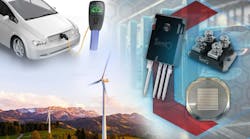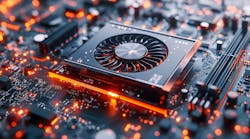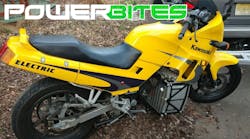Step-Down DC-DC Converters Built for Portable Battery-Powered Apps
Nexperia’s latest series of step-down DC-DC converters delivers high standby and operating efficiency, providing greater flexibility for designing fixed and portable battery-powered applications across consumer, industrial, and automotive end-markets.
The NEX30606 offers a choice of 16 resistor-settable output voltages from input voltages ranging from 1.8 to 5.0 V while generating up to 600 mA of output current. Its low operating quiescent current (Iq = 220 μA) suits it for wearable consumer applications like hearing aids, medical sensors, patches, and monitors as well as smart meters, asset-tracking and industrial (IIoT) devices. It features >90% switching efficiency for load currents ranging from 1 to 400 mA with only 10mV of output voltage ripple.
The NEX40400 step-down converter combines high efficiency with low operating Iq (60 μA typ.) and can provide up to 600-mA output from a wide 4.5- to 40-V input range. It uses pulse frequency modulation (PFM) to provide high efficiency at low to mid loads and spread-spectrum technology to minimize EMI. Thus, it’s well-suited for industrial distributed power systems and grid infrastructure applications.
The low shutdown supply current (0.3 μA) also makes the NEX40400 suitable for use in battery-powered home appliances. Nexperia plans to release an AEC-Q100-qualified version of the converter later in 2025.
The NEX30606 is housed in a space-saving WLCSP package measuring only 1.09 × 0.74 mm with a 0.35-mm pitch, which is almost 50% smaller than similar competing converters. The NEX40400 comes in a cost-effective, 6-lead SOT8061-1 (TSOT23-6) plastic, surface-mounted package measuring 2.9 × 2.8 mm.
To learn more about Nexperia’s step-down DC-DC converters, click here.
Next in This Issue of PowerBites
More PowerBites
About the Author
Lee Goldberg
Contributing Editor
Lee Goldberg is a self-identified “Recovering Engineer,” Maker/Hacker, Green-Tech Maven, Aviator, Gadfly, and Geek Dad. He spent the first 18 years of his career helping design microprocessors, embedded systems, renewable energy applications, and the occasional interplanetary spacecraft. After trading his ‘scope and soldering iron for a keyboard and a second career as a tech journalist, he’s spent the next two decades at several print and online engineering publications.
Lee’s current focus is power electronics, especially the technologies involved with energy efficiency, energy management, and renewable energy. This dovetails with his coverage of sustainable technologies and various environmental and social issues within the engineering community that he began in 1996. Lee also covers 3D printers, open-source hardware, and other Maker/Hacker technologies.
Lee holds a BSEE in Electrical Engineering from Thomas Edison College, and participated in a colloquium on technology, society, and the environment at Goddard College’s Institute for Social Ecology. His book, “Green Electronics/Green Bottom Line - A Commonsense Guide To Environmentally Responsible Engineering and Management,” was published by Newnes Press.
Lee, his wife Catherine, and his daughter Anwyn currently reside in the outskirts of Princeton N.J., where they masquerade as a typical suburban family.
Lee also writes the regular PowerBites series.





